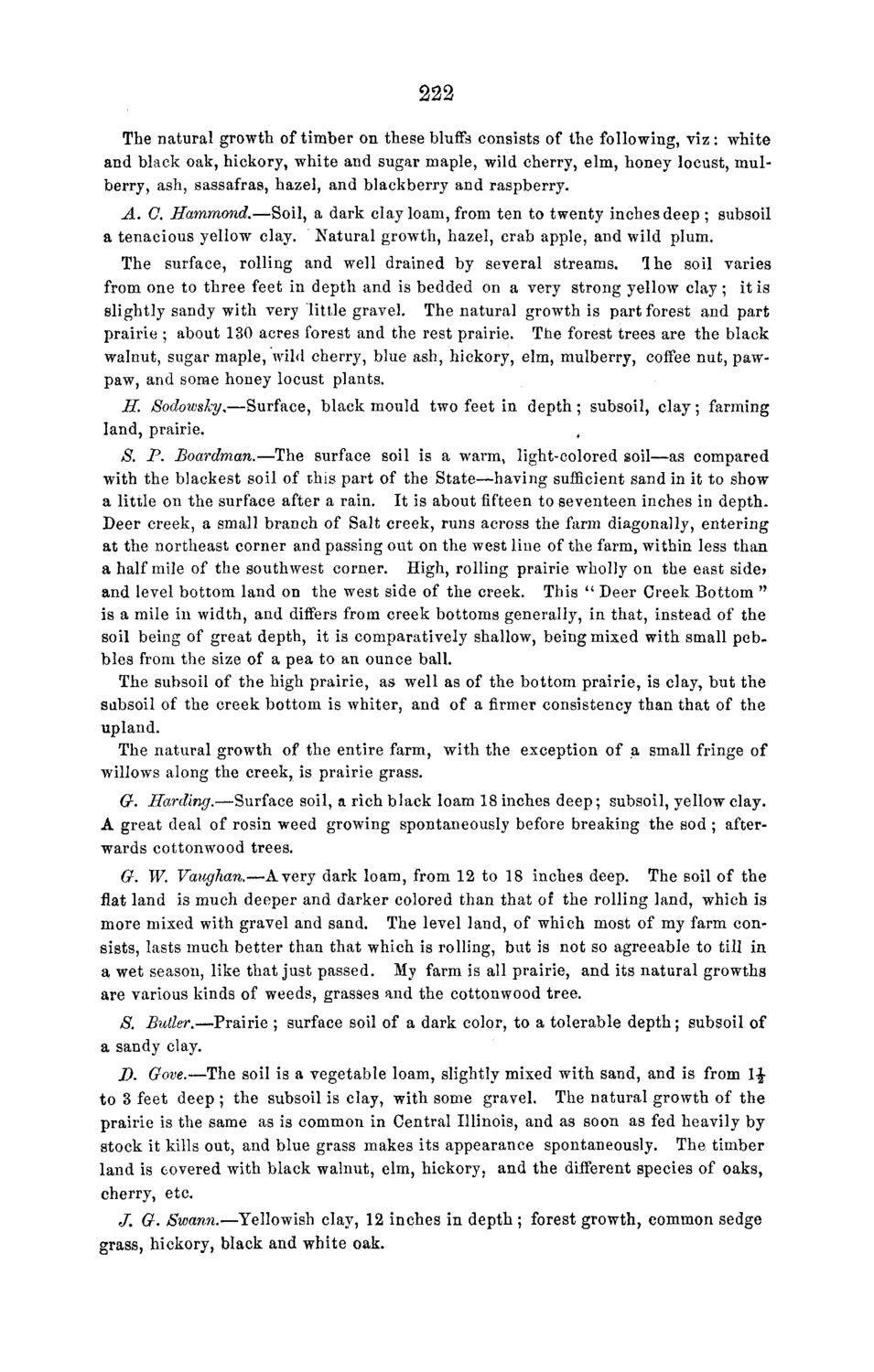| |
| |
Caption: Board of Trustees Minutes - 1868
This is a reduced-resolution page image for fast online browsing.

EXTRACTED TEXT FROM PAGE:
222 The natural growth of timber on these bluffs consists of the following, viz : white and black oak, hickory, white and sugar maple, wild cherry, elm, honey locust, mulberry, ash, sassafras, hazel, and blackberry and raspberry. A, C. Hammond.—Soil, a dark clay loam, from ten to twenty inches deep ; subsoil a tenacious yellow clay. Natural growth, hazel, crab apple, and wild plum. The surface, rolling and well drained by several streams. I h e soil varies from one to three feet in depth and is bedded on a very strong yellow clay; it is slightly sandy with very little gravel. The natural growth is part forest and part prairie ; about 130 acres forest and the rest prairie. The forest trees are the black walnut, sugar maple, wild cherry, blue ash, hickory, elm, mulberry, coffee nut, pawpaw, and some honey locust plants. H. Sodowsky.—Surface, black mould two feet in depth; subsoil, clay; farming land, prairie. S. P. Boardman.—The surface soil is a warm, light-colored soil—as compared with the blackest soil of this part of the State—having sufficient sand in it to show a little on the surface after a rain. It is about fifteen to seventeen inches in depth. Deer creek, a small branch of Salt creek, runs across the farm diagonally, entering at the northeast corner and passing out on the west line of the farm, within less than a half mile of the southwest corner. High, rolling prairie wholly on the east side* and level bottom land on the west side of the creek. This " Deer Creek Bottom " is a mile in width, and differs from creek bottoms generally, in that, instead of the soil being of great depth, it is comparatively shallow, being mixed with small pebbles from the size of a pea to an ounce ball. The subsoil of the high prairie, as well as of the bottom prairie, is clay, but the subsoil of the creek bottom is whiter, and of a firmer consistency than that of the upland. The natural growth of the entire farm, with the exception of a small fringe of willows along the creek, is prairie grass. G. Harding.—Surface soil, a rich black loam 18 inches deep; subsoil, yellow clay. A great deal of rosin weed growing spontaneously before breaking the sod ; afterwards cottonwood trees. G. W. Vaughan.—Avery dark loam, from 12 to 18 inches deep. The soil of the flat land is much deeper and darker colored than that of the rolling land, which is more mixed with gravel and sand. The level land, of which most of my farm consists, lasts much better than that which is rolling, but is not so agreeable to till in a wet season, like that just passed. My farm is all prairie, and its natural growths are various kinds of weeds, grasses and the cottonwood tree. $. Butler.—Prairie ; surface soil of a dark color, to a tolerable depth; subsoil of a sandy clay. D. Gove.—The soil is a vegetable loam, slightly mixed with sand, and is from 1£ to 3 feet deep ; the subsoil is clay, with some gravel. The natural growth of the prairie is the same as is common in Central Illinois, and as soon as fed heavily by stock it kills out, and blue grass makes its appearance spontaneously. The timber land is covered with black walnut, elm, hickory, and the different species of oaks, cherry, etc. J. G. Swann.—Yellowish clay, 12 inches in depth ; forest growth, common sedge grass, hickory, black and white oak.
| |